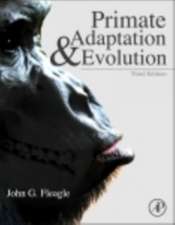Ecology and Behaviour of the African Buffalo: Social inequality and decision making: Chapman & Hall Wildlife Ecology and Behaviour Series
Autor H.H.T Prinsen Limba Engleză Paperback – 30 noi 1995
Preț: 643.34 lei
Preț vechi: 756.86 lei
-15% Nou
Puncte Express: 965
Preț estimativ în valută:
123.10€ • 128.87$ • 101.86£
123.10€ • 128.87$ • 101.86£
Carte tipărită la comandă
Livrare economică 05-19 aprilie
Preluare comenzi: 021 569.72.76
Specificații
ISBN-13: 9780412725203
ISBN-10: 0412725207
Pagini: 293
Ilustrații: XXIII, 293 p.
Dimensiuni: 155 x 235 x 20 mm
Greutate: 0.5 kg
Ediția:Softcover reprint of the original 1st ed. 1996
Editura: SPRINGER NETHERLANDS
Colecția Springer
Seria Chapman & Hall Wildlife Ecology and Behaviour Series
Locul publicării:Dordrecht, Netherlands
ISBN-10: 0412725207
Pagini: 293
Ilustrații: XXIII, 293 p.
Dimensiuni: 155 x 235 x 20 mm
Greutate: 0.5 kg
Ediția:Softcover reprint of the original 1st ed. 1996
Editura: SPRINGER NETHERLANDS
Colecția Springer
Seria Chapman & Hall Wildlife Ecology and Behaviour Series
Locul publicării:Dordrecht, Netherlands
Public țintă
ResearchCuprins
1 Distribution of resources in time and space.- 1.1 General background.- 1.2 Ecology of the landscape.- 1.3 Water requirements and distribution of water.- 1.4 Waxing and waning of food resources.- 1.5 Buffalo diet composition.- 1.6 Grass and sedge production.- 1.7 Grass and sedge consumption.- 1.8 Food quality.- 2 Food for the buffalo.- 2.1 Energy and protein requirements for buffalo.- 2.2 Food intake and sward density.- 2.3 Buffalo feeding activity.- 2.4 Buffalo as mixed feeders?.- 2.5 Are buffalo time limited or resource limited?.- 3 Social organization of buffalo cows.- 3.1 Distinguishing sex and age categories and assessing condition.- 3.2 Fitness and social inequality.- 3.3 The buffalo herd as a discrete unit.- 3.4 Fusion-fission society.- 4 Social organization of buffalo bulls.- 4.1 Bull movements on a macro-scale.- 4.2 Bull movements between social environments.- 4.3 Dominance interactions between adult bulls.- 4.4 Re-entrant consecutive polygyny.- 5 Population dynamics, catastrophes and stability.- 5.1 Are buffalo the preferred prey of lions?.- 5.2 Different causes of death.- 5.3 Risk, sex and age.- 5.4 Annual mortality.- 5.5 Rinderpest.- 5.6 The rinderpest outbreak of 1959.- 5.7 Catastrophic diseases.- 5.8 Risk of disease and social inequality.- 5.9 The Manyara censuses.- 5.10 Functional stability.- 5.11 Compensation.- 5.12 Condition and reproduction.- 5.13 Herd size and growth rate: the effects of poaching.- 6 Competition for food.- 6.1 The four major grazers.- 6.2 Wildebeest and zebra grazing activity.- 6.3 Elephant feeding activity.- 6.4 Similarities and differences in adaptation between the four species.- 6.5 Zebra and wildebeest: minor competitors with buffalo.- 6.6 Elephant: the major competitor.- 7 Patch selection: predators and grazing by ‘rule ofthumb’.- 7.1 Zones of danger.- 7.2 Vigilance and predator detection.- 7.3 Buffalo ignore predation risk when deciding where to graze.- 7.4 Patch selection and regrazing.- 7.5 Changing patch utilization.- 7.6 Preventing wrong decisions.- 7.7 Cognition, intelligence and decision-making.- 7.8 Collecting information.- 8 Selecting grazing grounds: a case of voting.- 8.1 Key findings to understand communal decision-taking.- 8.2 A difficult task: individual judgement.- 8.3 First evidence for communal decision-taking.- 8.4 Orientations of buffalo when grazing or resting.- 8.5 Which of the sexes or age classes show ‘Voting’ behaviour?.- 8.6 Voting.- 8.7 Election or consensus?.- 8.8 Pooled expert opinion.- 8.9 A remarkable adaptation: sociality in optimal form.- 9 The effects of ecology on social organization.- 9.1 Phylogeny and social organization of buffalo.- 9.2 Intraspecific variation in social organization.- 9.3 Buffalo of Manyara as compared with those of the Serengeti.- 9.4 Social inequality.- 9.5 The evolution of sociality and information sharing.- Appendix: Protein and energy requirements.- References.
Recenzii
This book will come to be seen as a milestone in the development and testing of ideas in behavioural ecology...This is a brilliant book. - Mammal News; In all, this is a highly informative and easily readable text which makes an excellent companion to, and extension of, the earlier work of Grimsdell (1969) and Sinclair (1977), and helps dispel many of the old myths propagated by white hunters about this animal. - Journal of Animal Ecology; ...of great interest and value to people working on related species in wild, domestic or feral conditions...Specialists in African ungulates will appreciate the generous provision of detail...excellent photographs... - Animal Behaviour; After many years of original and innovative research on the African buffalo, particulary at Lake Manyara in northern Tanzania, Herbert Prins has now summarized the results of much of this widely-respected work in this fascinating book. Such a case-study has wide implications for research on social structure and organization in other species, and these are explored within the book - Ethology Ecology & Evolution; This book is a landmark in socio-ecological studies of ungulates...no other work that I can recall has gone into such detail and sifted through the data so thoroughly....Ecology and Behavior of the African Buffalo is an exceptional interesting study, one that sets a new and higher standard for future studies. -African Worldlife Update













